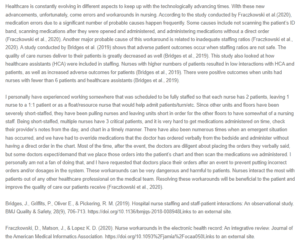Nursing Staffing Levels and Medication Errors Due to Nursing Workarounds
Do you need any assistance on a nursing assignment? We offer quality help, Contact us.
Hello,
This is an amazing post. You have shared your personal experience related to a workaround you have witnessed in your nursing career. Your focus on nursing staffing levels and medication errors is a brilliant way of explaining workarounds in nursing and highlighting the actual impacts of workarounds in nursing practice. Agreeably, most errors in nursing are mostly related to the nurse-to-patient ratios. One nurse serving several patients risks burnout and the occurrence of errors during the medication process. Notably, technological advances and the adoption of healthcare technologies such as electronic medication prescribing and dispensing have greatly improved the efficiency of nursing care delivery and significantly reduced the occurrence of medication errors and related harm (Roumeliotis et al., 2019). However, due to the efficiency these technologies promise, nurses tend to be assigned multiple patients. The need to meet the demands of each patient assigned to a nurse can be the major cause of them engaging in these workarounds in care delivery. As you have argued, these workarounds can be very dangerous and harmful to patients. In fact, evidence shows that despite using technologies such as bar-code-assisted medication administration in hospital settings, workarounds were a risk factor for medication errors during the medication administration process (Van Der Veen et al., 2018). From a personal perspective, although workarounds pose a risk of errors in nursing, they can sometimes be driven by good intentions and necessity, for instance, when a patient demands emergency care or when multiple patients need attention while the staffing is low. Nonetheless, regardless of whether driven by necessity, nurses must ensure that the care provided is safe and directed towards meeting individual patient care needs.
References
Roumeliotis, N., Sniderman, J., Adams-Webber, T., Addo, N., Anand, V., Rochon, P., Taddio, A., & Parshuram, C. (2019). Effect of Electronic Prescribing Strategies on Medication Error and Harm in Hospital: a Systematic Review and Meta-analysis. Journal of General Internal Medicine, 34(10), 2210. https://doi.org/10.1007/S11606-019-05236-8
Van Der Veen, W., Van Den Bemt, P. M. L. A., Wouters, H., Bates, D. W., Twisk, J. W. R., De Gier, J. J., Taxis, K., Duyvendak, M., Luttikhuis, K. O., Ros, J. J. W., Vasbinder, E. C., Atrafi, M., Brasse, B., & Mangelaars, I. (2018). Association between workarounds and medication administration errors in bar-code-assisted medication administration in hospitals. Journal of the American Medical Informatics Association, 25(4), 385–392. https://doi.org/10.1093/JAMIA/OCX077
ORDER A PLAGIARISM-FREE PAPER HERE
We’ll write everything from scratch
Question

Nursing Workarounds – Nursing Staffing Levels and Medication Errors
Healthcare is constantly evolving in different aspects to keep up with the technologically advancing times. With these new advancements, unfortunately, come errors and workarounds in nursing. According to the study conducted by Fraczkowski et al.(2020), medication errors due to a significant number of probable causes happen frequently. Some causes include not scanning the patient’s ID band, scanning medications after they were opened and administered, and administering medications without a direct order (Fraczkowski et al., 2020). Another major probable cause of this workaround is related to inadequate staffing ratios (Fraczkowski et al., 2020). A study conducted by Bridges et al. (2019) shows that adverse patient outcomes occur when staffing ratios are not safe. The quality of care nurses deliver to their patients is greatly decreased as well (Bridges et al., 2019). This study also looked at how healthcare assistants (HCA) were included in staffing. Nurses with higher numbers of patients resulted in low interactions with HCA and patients, as well as increased adverse outcomes for patients (Bridges et al., 2019). There were positive outcomes when units had nurses with fewer than 6 patients and healthcare assistants (Bridges et al., 2019).
I personally have experienced working somewhere that was scheduled to be fully staffed so that each nurse has 2 patients, leaving 1 nurse to a 1:1 patient or as a float/resource nurse that would help admit patients/turn/etc. Since other units and floors have been severely short-staffed, they have been pulling nurses and leaving units short in order for the other floors to have somewhat of a nursing staff. Being short-staffed, multiple nurses have 3 critical patients, and it is very hard to get medications administered on time, check their provider’s notes from the day, and chart in a timely manner. There have also been numerous times when an emergent situation has occurred, and we have had to override medications that the doctor has ordered verbally from the bedside and administer without having a direct order in the chart. Most of the time, after the event, the doctors are diligent about placing the orders they verbally said, but some doctors expect/demand that we place those orders into the patient’s chart and then scan the medications we administered. I personally am not a fan of doing that, and I have requested that doctors place their orders after an event to prevent putting incorrect orders and/or dosages in the system. These workarounds can be very dangerous and harmful to patients. Nurses interact the most with patients out of any other healthcare professional on the medical team. Resolving these workarounds will be beneficial to the patient and improve the quality of care our patients receive (Fraczkowski et al., 2020).
Bridges, J., Griffits, P., Oliver E., & Pickering, R. M. (2019). Hospital nurse staffing and staff-patient interactions: An observational study. BMJ Quality & Safety, 28(9), 706-713. https://doi.org/10.1136/bmjqs-2018-008948Links to an external site.
Fraczkowski, D., Matson, J., & Lopez K. D. (2020). Nurse workarounds in the electronic health record: An integrative review. Journal of the American Medical Informatics Association. https://doi.org/10.1093%2Fjamia%2Focaa050Links to an external site.

